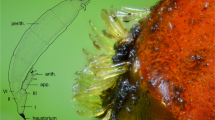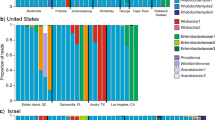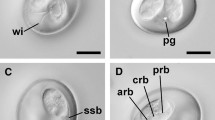Abstract
Emmonsia crescens is known as an environmental pathogen causing adiaspiromycosis in small rodents. As the generic name Emmonsia is no longer available for this species, its taxonomic position is re-evaluated. The intraspecific variation of Emmonsia crescens was analyzed using molecular, morphological, and physiological data, and the relationship between frequency of adiaspiromycosis and body temperature of host animals was explored. A North American and a pan-global lineage could be discerned, each with subclusters at low genetic distance. European strains produced the classical type of very large adiaspores, while in the North American lineage adiaspores relatively small, resembling the broad-based budding cells of Blastomyces. Members of the closely related genus Emergomyces may exhibit large, broad-based in addition to small, narrow-based budding cells. We conclude that the morphology of the pathogenic phase in these fungi differs gradationally between species and even populations, and is therefore less suitable as a diagnostic criterion for generic delimitation. Two Emmonsia species are reclassified in Emergomyces.






Similar content being viewed by others
Abbreviations
- AFLP:
-
Amplified fragment length polymorphism
- BCP-MS-G:
-
Bromocresol purple-milk solids-glucose
- E.:
-
Emmonsia
- Hd:
-
Haplotype diversity
- IA:
-
Indexes of association
- ITS:
-
Internal transcribed spacer regions
- LSU:
-
Large subunit rDNA
- ML:
-
Maximum likelihood
- rPB2 :
-
RNA polymerase II
- SNP:
-
Single nucleotide polymorphism
- TEF3 :
-
Translation elongation factor 3-α
- TUB2 :
-
β-Tubulin
- TOTM:
-
Tween 80 opacity test medium
References
Ciferri R, Montemartini A. Taxonomy of Haplosporangium parvum. Mycopath Mycol Appl. 1959;10:303–16.
Emmons CW, Jellison WL. Emmonsia crescens sp. n. and adiaspiromycosis (haplomycosis in mammals). Ann NY Acad Sci. 1960;89:91–101.
Sigler L. Adiaspiromycosis and other infections caused by Emmonsia species. In: Hodder A, editor. Topley & Wilson’s microbiology and microbial. 10th ed. London: Wiley; 2005. p. 809–24.
Dvořak J, Otčenašek M, Rosicky B. Adiaspiromycosis caused by Emmonsia crescens, Emmons and Jellison 1960. Studie ČSAV (Acad Praha). 1973;14:1–120.
Jiang Y, Dukik K, Muñoz JF, Sigler L, Schwartz IS, Govender NP, et al. Phylogeny, ecology and taxonomy of systemic pathogens and their relatives in Ajellomycetaceae (Onygenales): Blastomyces, Emergomyces, Emmonsia, Emmonsiellopsis. Fung Divers. 2018;90:245–91. https://doi.org/10.1007/s13225-018-0403-y.
Schwartz IS, McLoud JD, Berman D, Botha A, Lerm B, Colebunders R, et al. Molecular detection of airborne Emergomyces africanus, a thermally dimorphic fungal pathogen, in Cape Town, South Africa. PLoS Negl Trop Dis. 2018;12(1):e0006174. https://doi.org/10.1371/journal.pntd.0006174.
Schwartz IS, Lerm B, Hoving JC, Kenyon C, Horsnell WG, Basson WJ, et al. Emergomyces africanus in soil, South Africa. Emerg Infect Dis. 2018;24:377–80. https://doi.org/10.3201/eid2402.171351.
Cronjé N, Schwartz IS, Retief L, Bastos ADS, Matthee S, Preiser W, et al. Attempted molecular detection of the thermally dimorphic human fungal pathogen Emergomyces africanus in terrestrial small mammals in South Africa. Med Mycol. 2018;56:510–3. https://doi.org/10.1093/mmy/myx065.
Seyedmousavi S, de Hoog GS, Guillot J, Verweij PE. Emerging and epizootic fungal infections in animals. Cham: Springer; 2018.
Hubálek Z, Nesvadbová J, Halouzka J. Emmonsiosis of rodents in an agroecosystem. Med Mycol. 1998;36:387–90.
Borman AM, Simpson VR, Palmer MD, Linton CJ, Johnson EM. Adiaspiromycosis due to Emmonsia crescens is widespread in native British mammals. Mycopathologia. 2009;168:153–63. https://doi.org/10.1007/s11046-009-9216-6.
Sigler L. Agents of adiaspiromycosis. 1998; p. 571–583. In L. Ajello and R. Hay (ed.), Topley & Wilson’s microbiology and microbial infections, 9th edn, vol. 4. London: Arnold.
Danesi P, Falcaro C, Dukik K, Jiang Y, Rizzoli AP, Allavena R, et al. Molecular diagnosis of Emmonsia-like fungi occurring in wild animals. Mycopathologia. 2019. https://doi.org/10.1007/s11046-019-00353-8.
Samson RA, Houbraken J, Thrane U, Frisvad JC, Andersen B. Food and indoor fungi. Utrecht: CBS KNAW Biodiversity Center; 2010.
Slifkin M. Tween 80 opacity test responses of various Candida species. J Clin Microbiol. 2000;38:4626–8.
Fischer JB, Kane J. The detection of contamination in Trichophyton rubrum and Trichophyton mentagrophytes. Mycopathologia. 1971;43:169–80.
Summerbell RC, Rosenthal SA, Kane J. Rapid method for differentiation of Trichophyton rubrum, Trichophyton mentagrophytes, and related dermatophyte species. J Clin Microbiol. 1988;26:2279–82.
Tamura K, Peterson D, Peterson N, Stecher G, Nei M, Kumar S. MEGA5: molecular evolutionary genetics analysis using maximum likelihood, evolutionary distance, and maximum parsimony methods. Mol Biol Evol. 2011;28:2731–9. https://doi.org/10.1093/molbev/msr121.
Stamatakis A. RaxML version 8: a tool for phylogenetic analysis and post analysis of large phylogenies. Bioinformatics. 2014;30:1312–3. https://doi.org/10.1093/bioinformatics/btu033.
Ramos-Onsins SE, Sánchez-Gracia A. DnaSP 6: DNA sequence polymorphism analysis of large data sets. Mol Biol Evol. 2017;34:3299–302.
Agapow P, Burt A. Indices of multilocus linkage disequilibrium. Mol Ecol Notes. 2001;1:101–2. https://doi.org/10.1046/j.1471-8278.2000.00014.x.
Smith JM, Smith NH, O’Rourke M, Spratt BG. How clonal are bacteria? Proc Nat Acad Sci USA. 1993;90:4384–8.
Su H, Packeu A, Ahmed SA, Al-Hatmi AMS, Blechert O, İlkit M, et al. Species distinction in the Trichophyton rubrum complex. J Clin Microbiol. 2019;57(9):e00352-19. https://doi.org/10.1128/jcm.00352-19.
Hubálek Z. Emmonsiosis of wild rodents and insectivores in Czechland. J Wildl Dis. 1999;35:243–9. https://doi.org/10.7589/0090-3558-35.2.243.
Mörner T, Avenäs A, Mattsson R. Adiaspiromycosis in a European beaver from Sweden. J Wildl Dis. 1999;35:367–70. https://doi.org/10.7589/0090-3558-35.2.367.
Simpson VR, Gavier-Widen D. Fatal adiaspiromycosis in a wild Eurasian otter (Lutra lutra). Vet Rec. 2000;147:239–41. https://doi.org/10.1136/vr.147.9.239.
Hughes K, Borman AM. Adiaspiromycosis in a wild European rabbit, and a review of the literature. J Vet Diagn Investig. 2018;30:614–8. https://doi.org/10.1177/1040638718772631.
Chantrey JC, Borman AM, Johnson EM, Kipar A. Emmonsia crescens infection in a British water vole (Arvicola terrestris). Jpn J Med Mycol. 2006;44:375–8. https://doi.org/10.1080/13693780500354222.
Seixas F, Travassos P, Pinto ML, Pires I, Pires MA. Pulmonary adiaspiromycosis in a European hedgehog (Erinaceus europaeus) in Portugal. Vet Rec. 2006;158:274–5. https://doi.org/10.1136/vr.158.8.274.
Malatesta D, Simpson VR, Fontanesi L, Fusillo R, Marcelli M, Bongiovanni L, et al. First description of adiaspiromycosis in an Eurasian otter (Lutra lutra) in Italy. Vet Italy. 2014;50:199–202. https://doi.org/10.12834/VetIt.40.1916.8.
Morandi F, Galuppi R, Buitrago MJ, Delogu M, Lowenstine LJ, Panarese S, et al. Disseminated pulmonary adiaspiromycosis in a crested porcupine (Hystrix cristata Linnaeus, 1758). J Wildl Dis. 2012;48:523–5. https://doi.org/10.7589/0090-3558-48.2.523.
Dolka I, Gizejewska A, Gizejewski Z, Kołodziejska-Lesisz J, Klucinski W. Pulmonary adiaspiromycosis in the Eurasian beaver (Castor fiber) inhabiting Poland. Pol J Vet Sci. 2017;20:615–7. https://doi.org/10.1515/pjvs-2017-0077.
Hubálek Z, Burda H, Scharff A, Heth G, Nevo E, Sumbera R, et al. Emmonsiosis of subterranean rodents (Bathyergidae, Spalacidae) in Africa and Israel. Med Mycol. 2005;43:691–7. https://doi.org/10.1080/13693780500179553.
Kim TH, Han JH, Chang SN, Kim DS, Abdelkader TS, Seok SH, et al. Adiaspiromycosis of an Apodemus agrarius captured wild rodent in Korea. Lab Anim Res. 2012;28:67–9. https://doi.org/10.5625/lar.2012.28.1.67.
Matsuda K, Niki H, Yukawa A, Yanagi M, Souma K, Masuko T, et al. First detection of adiaspiromycosis in the lungs of a deer. J Vet Med Sci. 2015;77:981–3. https://doi.org/10.1292/jvms.15-0083.
Johnstone AC, Hussein HM, Woodgyer A. Adiaspiromycosis in suspected cases of pulmonary tuberculosis in the common brushtail possum (Trichosurus vulpecula). N Z Vet J. 1993;41:175–8. https://doi.org/10.1080/00480169.1993.35765.
Albassam MA, Bhatnagar R, Lillie LE, Roy L. Adiaspiromycosis in striped skunks in Alberta, Canada. J Wildl Dis. 1986;22:13–8. https://doi.org/10.7589/0090-3558-22.1.13.
Peterson SW, Sigler L. Molecular genetic variation in Emmonsia crescens and Emmonsia parva, etiologic agents of adiaspiromycosis, and their phylogenetic relationship to Blastomyces dermatitidis (Ajellomyces dermatitidis) and other systemic fungal pathogens. J Clin Microbiol. 1998;36:2918–25.
Sigler L. Ajellomyces crescens sp. nov., taxonomy of Emmonsia spp., and relatedness with Blastomyces dermatitidis (teleomorph Ajellomyces dermatitidis). J Med Vet Mycol. 1996;34(5):303–14.
Boily P. Individual variation in metabolic traits of wildnine-banded armadillos (Dasypus novemcinctus), and theaerobic capacity model for the evolution of endothermy. J Exp Biol. 2002;205:3207–14.
Acknowledgements
The authors thank Lynne Sigler, Edmonton, Canada, for constructive discussions, and Xinlei Fan from Beijing Forestry University, and Bingbing Zhang, School of Public Health, Guizhou Medical University, for their important contributions to the methodology and statistical analysis.
Funding
This work was supported by the District science foundation program (NSFC No. 81960368) from National Natural Science Foundation of China.
Author information
Authors and Affiliations
Contributions
YJ carried out the literature search, strains collection, DNA extraction and sequencing, phylogenetic tree construction, physiology tests, participated in the data analysis and drafted the manuscript. CT performed the genetic data and split tree analysis and interpretation, contributed to the discussion and revision of the manuscript. SA performed the haplotype data analysis. FH and BGVDE carried out the AFLP data analysis interpretation. ZS carried out the statistical analysis. YJ, HL, PEV and SdH participated in the design of the study, statistical analysis and manuscript revision and review. All authors read and approved the manuscript.
Corresponding authors
Ethics declarations
Conflict of interest
The authors declare that they have no conflict of interest.
Additional information
Handling Editor: Abdullah Mohammed Said Al-Hatmi.
Publisher's Note
Springer Nature remains neutral with regard to jurisdictional claims in published maps and institutional affiliations.
Electronic supplementary material
Below is the link to the electronic supplementary material.
Rights and permissions
About this article
Cite this article
Jiang, Y., Tsui, C.K.M., Ahmed, S.A. et al. Intraspecific Diversity and Taxonomy of Emmonsia crescens. Mycopathologia 185, 613–627 (2020). https://doi.org/10.1007/s11046-020-00475-4
Received:
Accepted:
Published:
Issue Date:
DOI: https://doi.org/10.1007/s11046-020-00475-4




